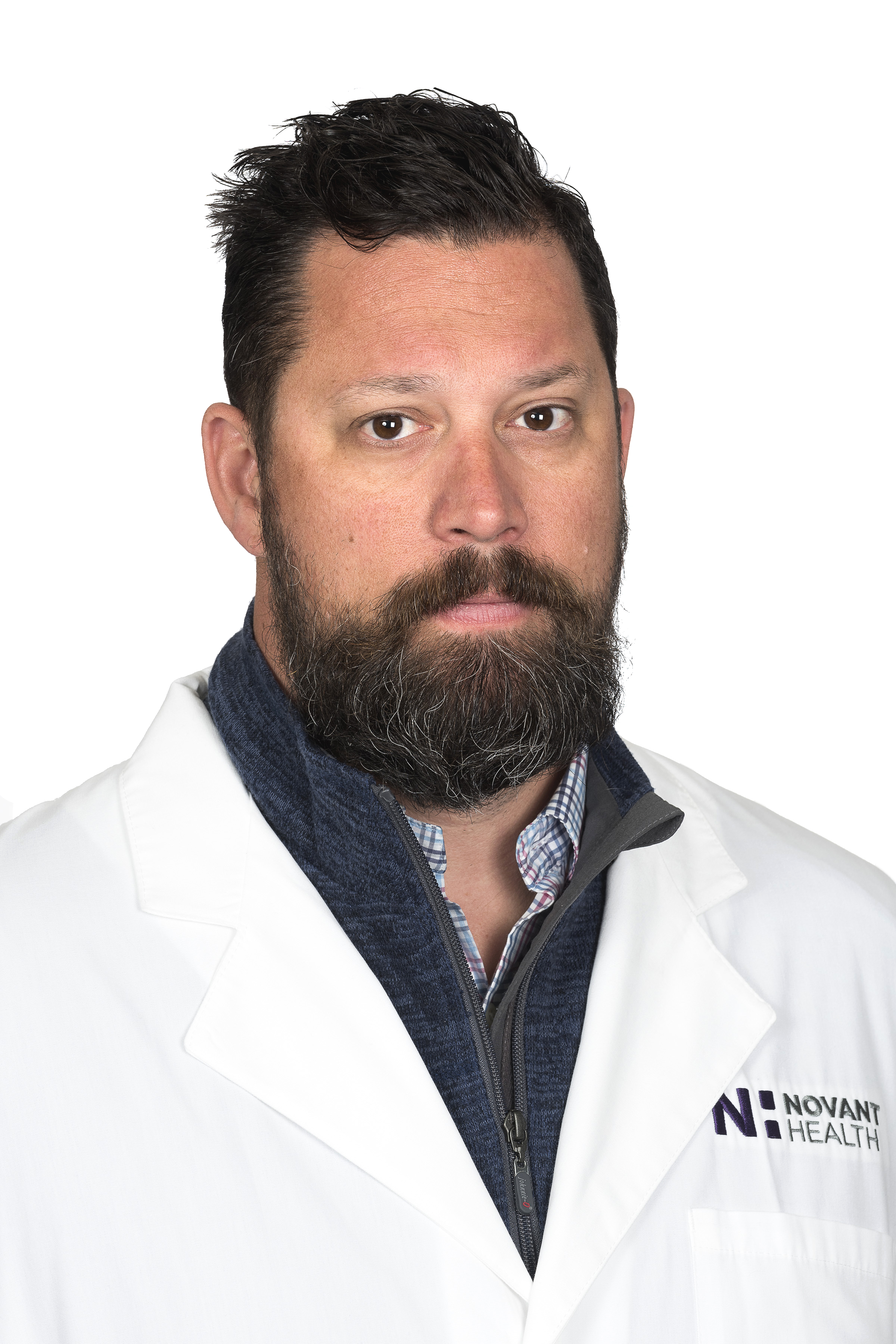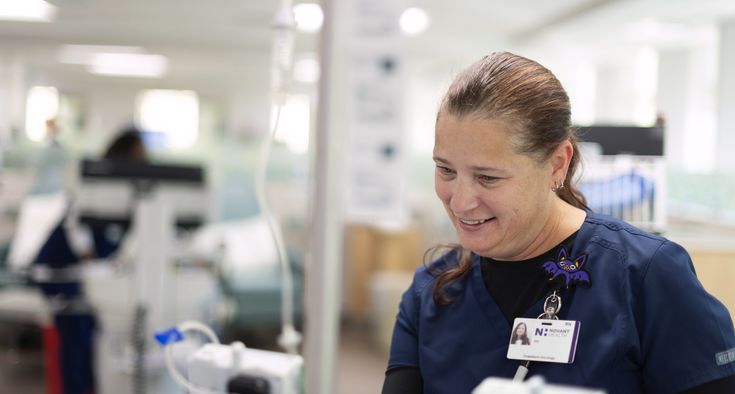Chris Mooney, 60, was at the end of his rope.
First came the excruciating pain from movements as simple as getting out of a car. Then his back, hip, leg and foot pain became ongoing.
Mooney tried medication, physical therapy and injections, but things weren’t getting better, and soon, his leg muscles grew weak. For a school custodian whose day consists of physical labor — and a “Pa” who loves wrestling with his 10-year-old grandson — this was terrifying.
“I thought the worst,” Mooney said. “Am I losing my ability to walk? Am I losing my ability to move, do ordinary things, go to the store? The unknown was what worried me.”
Flash forward a few months, and Mooney’s back to walking 20,000 steps a day without pain — thanks to a matchbook-sized device and a clinical trial. What happened?
Expand your treatment options and help others through clinical trials.
Diabetic neuropathy: the ‘why’ behind Chris’s pain
After consultation and testing at Novant Health Spine Specialists - Kimel Park in Winston-Salem in August 2023, Mooney learned he had diabetic neuropathy, a type of nerve damage that can occur in up to 50% of people with diabetes when blood sugar is too high.
Over the last few years, Mooney worked hard to manage his Type 2 diabetes — but his blood sugar hadn’t always been well controlled during the last two decades.
This led to “peripheral neuropathy,” the most common type of diabetic neuropathy, which can cause sharp pain, muscle weakness, a burning sensation and numbness, and can seriously damage the feet.
The good news? Although neuropathy can’t be reversed, Mooney had an intriguing option to help him deal with the pain, thanks to Novant Health’s participation in leading-edge research.
A clinical trial offers new treatment option
Mooney’s team offered him the chance to enroll in a clinical trial for a spinal cord stimulator (SCS).
An SCS is a 2-inch device implanted in the spinal cord that blocks the messages about nerve pain being sent to your brain. An SCS doesn’t repair nerve damage, but it interrupts the pain messages with stimulation — so instead of feeling pain, the user feels a gentle buzzing or vibrating sensation, which they can control with a remote control.
In previous phases of the clinical trial, this SCS had been shown to help other patients with diabetic neuropathy. The study team was almost certain it could help Mooney too.
A skeptic turned believer
Mooney was initially skeptical, wondering, “Do I really want to be a guinea pig?” (It’s understandable that many of us view clinical trials this way. But patients are not really guinea pigs. See below for more on this.)
However, as he learned more about the safety and monitoring that goes into the clinical trial process — and as standard treatments failed — Mooney became open to the idea. “At this point, I will try anything,” he remembers saying.
Under the watchful eye of a principal investigator and study team, Mooney had the SCS taped to his back for a one-week test run, and learned to use the remote control to change frequencies and settings of the SCS.
“It feels like a vibration that goes down my back, hips and legs, similar to a massage chair but more intense,” Mooney said. And to his delight: it worked. “I could walk — I could do whatever I wanted,” Mooney said. “I had relief.”
Top scores for safety in NC
Novant Health received the most ‘As’ for patient safety in North Carolina from The Leapfrog Group. With a focus on safety, quality and patient experience, the national, industry-leading nonprofit, evaluates and assigns letter grades ranging from A to F to hospitals across the country. Novant Health’s hospitals with “A” grades outperform 70% of hospitals nationwide for safety and quality.
And so, just a few weeks later, Mooney had the SCS implanted in a short outpatient procedure. After a few days, Mooney was back in action. “The procedure wasn’t that big of a deal, but it made a huge impact on my life,” Mooney said.
Life today
These days, Mooney easily meets his 5 a.m. report time at North Surry High School, where he makes the school and grounds sparkle for 800+ students. Off the clock, he helps his 83-year-old parents maintain their house, and he welcomed a new grandbaby — a girl — in September.
He loves adjusting the spine stimulator in real time. “If I'm doing a lot of strenuous stuff, a lot of walking and lifting, I take that control and bump it up a little bit and keep right on going. On days I don't need that, I can lower it down,” Mooney said. “It’s given me my mobility back.”
Mooney now encourages others to consider participating in clinical research if they get the opportunity. “You don't ever know until you try,” Mooney said. To his study team, he would like to say, “Thank you for giving me back what I thought I was losing.”
Helping patients and moving medicine forward: Why does Novant Health participate in clinical trials?
Novant Health is dedicated to helping find new ways to prevent, detect, treat and cure various medical conditions. Clinical research is happening across our locations, each guided by a principal investigator, supported by a study team, and governed by an institutional review board (IRB).
The IRBs at Novant Health are made up of experienced Novant Health team members, physicians, nurses, pharmacists and community representatives. Before any research is done, the host site’s IRB will assess the study to make sure it is safe and ethical.
If there are concerns, they do not allow the study to occur. Once a study is approved, the IRB monitors the data coming in from the study to make sure the study remains safe for participants.
Patients are not subjected to random experiments like the guinea pigs of past scientific experiments.
Patients who meet study criteria can apply to become a voluntary participant in a clinical trial. Before joining, they are fully informed about the trial’s purpose, methods, and the possible risks and benefits to them. They are also free to exit the study at any time.
In a phase 4 clinical trial, like the one Chris Mooney participated in, researchers have already determined if a new treatment is safe, what side effects if has, if it works, and if it’s an improvement over standard treatment — and it’s already received regulatory approval. In phase 4, researchers gather even more information about how a treatment works — before the treatment is widely available to patients outside of the trial.

“By participating in clinical trials, we can provide therapies that patients wouldn't otherwise be able to have access to,” said Dr. Jeffrey Peacock, an anesthesiologist and pain medicine specialist at Novant Health Spine Specialists - Kimel Park in Winston-Salem who has worked on several clinical trials. “This, and other clinical trials like it, give our patients opportunities that improve their health and also help move our field further.”
Although nervous at first, Mooney is glad he participated. “The more I got into it, the more I saw how involved it was and how much people cared about it. I'm glad I've done it,” Mooney said. “My hope is that I can help somebody else to get the relief that they need so they can go on and have a better life and be out and able to do things like I am.”












